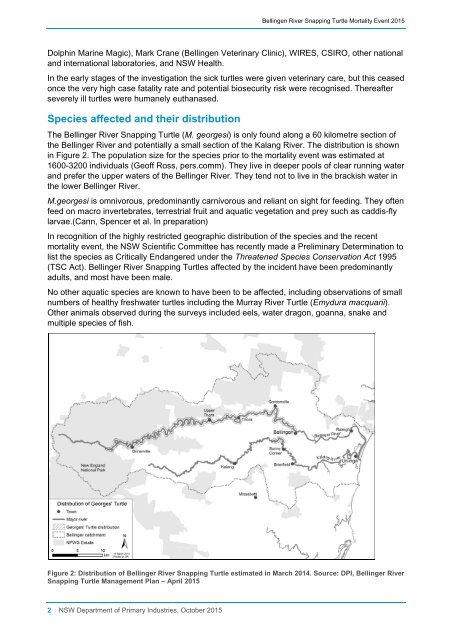Bellinger River Snapping Turtle Mortality Event 2015
BRST_Mortality_Event_DPI_Epidemiology_Report_2015_Final Copy
BRST_Mortality_Event_DPI_Epidemiology_Report_2015_Final Copy
Create successful ePaper yourself
Turn your PDF publications into a flip-book with our unique Google optimized e-Paper software.
Bellingen <strong>River</strong> <strong>Snapping</strong> <strong>Turtle</strong> <strong>Mortality</strong> <strong>Event</strong> <strong>2015</strong><br />
Dolphin Marine Magic), Mark Crane (Bellingen Veterinary Clinic), WIRES, CSIRO, other national<br />
and international laboratories, and NSW Health.<br />
In the early stages of the investigation the sick turtles were given veterinary care, but this ceased<br />
once the very high case fatality rate and potential biosecurity risk were recognised. Thereafter<br />
severely ill turtles were humanely euthanased.<br />
Species affected and their distribution<br />
The <strong>Bellinger</strong> <strong>River</strong> <strong>Snapping</strong> <strong>Turtle</strong> (M. georgesi) is only found along a 60 kilometre section of<br />
the <strong>Bellinger</strong> <strong>River</strong> and potentially a small section of the Kalang <strong>River</strong>. The distribution is shown<br />
in Figure 2. The population size for the species prior to the mortality event was estimated at<br />
1600-3200 individuals (Geoff Ross, pers.comm). They live in deeper pools of clear running water<br />
and prefer the upper waters of the <strong>Bellinger</strong> <strong>River</strong>. They tend not to live in the brackish water in<br />
the lower <strong>Bellinger</strong> <strong>River</strong>.<br />
M.georgesi is omnivorous, predominantly carnivorous and reliant on sight for feeding. They often<br />
feed on macro invertebrates, terrestrial fruit and aquatic vegetation and prey such as caddis-fly<br />
larvae.(Cann, Spencer et al. In preparation)<br />
In recognition of the highly restricted geographic distribution of the species and the recent<br />
mortality event, the NSW Scientific Committee has recently made a Preliminary Determination to<br />
list the species as Critically Endangered under the Threatened Species Conservation Act 1995<br />
(TSC Act). <strong>Bellinger</strong> <strong>River</strong> <strong>Snapping</strong> <strong>Turtle</strong>s affected by the incident have been predominantly<br />
adults, and most have been male.<br />
No other aquatic species are known to have been to be affected, including observations of small<br />
numbers of healthy freshwater turtles including the Murray <strong>River</strong> <strong>Turtle</strong> (Emydura macquarii).<br />
Other animals observed during the surveys included eels, water dragon, goanna, snake and<br />
multiple species of fish.<br />
Figure 2: Distribution of <strong>Bellinger</strong> <strong>River</strong> <strong>Snapping</strong> <strong>Turtle</strong> estimated in March 2014. Source: DPI, <strong>Bellinger</strong> <strong>River</strong><br />
<strong>Snapping</strong> <strong>Turtle</strong> Management Plan – April <strong>2015</strong><br />
2 NSW Department of Primary Industries, October <strong>2015</strong>


